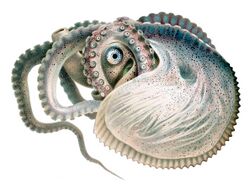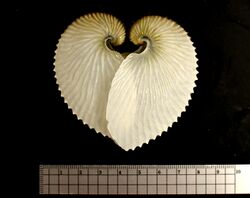Biology:Argonauta argo
| Greater argonaut | |
|---|---|

| |
| Argonauta argo inside its shell | |

| |
| Illustration from I Cefalopodi viventi nel Golfo di Napoli (1896) | |
| Scientific classification | |
| Domain: | Eukaryota |
| Kingdom: | Animalia |
| Phylum: | Mollusca |
| Class: | Cephalopoda |
| Order: | Octopoda |
| Family: | Argonautidae |
| Genus: | Argonauta |
| Species: | A. argo
|
| Binomial name | |
| Argonauta argo | |
| Synonyms | |
|
List
| |
Argonauta argo, also known as the greater argonaut, is a species of pelagic octopus belonging to the genus Argonauta. The Chinese name for this species translates as "white sea-horse's nest".[2]
A. argo was the first argonaut species to be described and is consequently the type species of the genus. The type specimen of A. argo was collected in the Mediterranean Sea and is deposited at the Linnean Society of London.[3]
Description
A. argo is the largest species in the genus and also produces the largest eggcase. Live animals have a characteristic blue sheen on the first arm pair and around the eyes.[2] The eggcase is characterised by two rows of small, sharp tubercles running along a narrow keel, smooth ribs across the walls of the shell, and a thickening along the shell aperture, which forms distinct protrusions or 'horns' on either side.[2] Argonauta cygnus Monterosato, 1889 was described based on a shell which lacked these protrusions, although it is now considered a junior synonym of A. argo. The greatest recorded size of an A. argo eggcase is 300 mm.[4][5]
A damaged beak of a female A. argo (ML = 40.0 mm; caught at [ ⚑ ] 20°56′N 175°33′W / 20.933°N 175.55°W), measuring 4.3 mm in hood length and 7.8 mm in crest length, is mentioned in A Handbook for the Identification of Cephalopod Beaks.[6]
Distribution and habitat
A. argo is cosmopolitan, occurring in tropical and subtropical waters worldwide.[2] A dwarf form exists in the Mediterranean Sea, which was described as Argonauta argo mediterranea Monterosato, 1914, although this taxon is now regarded as invalid.
Biology
The female of the species, like all argonauts, creates a paper-thin eggcase that coils around the octopus much like the way a nautilus lives in its shell, hence the name paper nautilus.
A. argo is thought to feed primarily on pelagic molluscs. The species is preyed on by numerous predators. It has been reported in the stomach contents of Alepisaurus ferox from the south-western Pacific.[7]

Males of this species reach sexual maturity at a mantle length (ML) of 8 mm.[8] Females mature at about double the size of Argonauta bottgeri and Argonauta hians.[8] They begin to secrete an eggcase at 6.5–7.0 mm ML.[8] Eggs are usually laid when females reach 14–15 mm ML, although the size at which this takes place differs across the animal's range.[9] A small A. argo residing in an 88 mm long eggcase was estimated to be carrying 48,800 embryos.[10] Females grow to 100 mm ML, while males do not exceed 20 mm ML.[2]
In the open ocean, A. argo has been observed attached to jellyfish.[11] This behaviour has been known for a long time,[11][12] although little was understood about the relationship prior to the work of Heeger et al. in 1992.[13][14] In "Predation on jellyfish by the cephalopod Argonauta argo", Heeger et al. describe their observations of a female A. argo found atop a host jellyfish. The argonaut was seen holding on to the aboral (exumbrellar) surface of the jellyfish using its lateral and ventral arms. The authors found that about half of the animal's aboral surface was damaged and large pieces of mesoglea were missing, presumably removed by the argonaut. Additionally, two holes, apparently bite marks, were found in the center of this area with channels leading from these holes into the gastral cavity of the jellyfish. The argonaut presumably used these channels to suck food particles from the gastral cavity. Heeger et al. suggested that "the association provided shelter or camouflage for the argonaut".[13][14]
Observations of captive A. argo females suggest that the expanded webs of the dorsal arms may aid the animal in feeding. Mark Norman mentions, "when food was touched against the spread webs, an arm shot out of the shell in a sweeping action, grabbing the prey".[2] Argonauts are not thought to actively hunt, but employ this method to catch animals that bump into them in the open ocean.[2]
A. argo is occasionally involved in mass strandings along the South Africa n and southern Australia n coastlines. The strandings are seasonal and generally occur between April and August, towards the end of the animals' spawning season.
Culture



In Japanese, this species is called "Aoi-gai" (kanji: 葵貝, Katakana: アオイガイ[15]), which means "Shell of Aoi" (not Malva but Asarum caulescens).[16] Japanese have compared two eggcases of argonauts lapped each other to a leaf of Asarum caulescens.[16] Another name is "Kaidako" (kanji: 貝蛸 or 貝鮹, Katakana: カイダコ[15]), which means "Shell Octopus".
Gallery
-
Eggcase of A. argo
-
Upper beak of a female
-
One of the earliest known depictions of A. argo, from Index Testarum Conchyliorum (1742) by Niccolò Gualtieri
-
Illustration of a female A. argo without its shell
References
- ↑ Allcock, L. (2014). "Argonauta argo". IUCN Red List of Threatened Species 2014: e.T163080A969616. doi:10.2305/IUCN.UK.2014-3.RLTS.T163080A969616.en. https://www.iucnredlist.org/species/163080/969616. Retrieved 12 November 2021.
- ↑ 2.0 2.1 2.2 2.3 2.4 2.5 2.6 Norman, M. (2000). Cephalopods: A World Guide. ConchBooks. pp. 190–191.
- ↑ Current Classification of Recent Cephalopoda
- ↑ Pisor, D. L. (2005). Registry of World Record Size Shells (4th ed.). Snail's Pace Productions and ConchBooks. p. 12.
- ↑ (in Russian) Nesis, K. N. (1982). Abridged key to the cephalopod mollusks of the world's ocean. Light and Food Industry Publishing House, Moscow, 385+ii pp. [Translated into English by B. S. Levitov, ed. by L. A. Burgess (1987), Cephalopods of the world. T. F. H. Publications, Neptune City, NJ, 351 pp.]
- ↑ Clarke, M. R. (1986). A Handbook for the Identification of Cephalopod Beaks. Oxford University Press. p. 244.
- ↑ Rancurel, P. (1970). "Les contenus stomacaux d' Alepisaurus ferox dans le sud-ouest Pacifique (Céphalopodes)" (in fr). Cah. O.R.S.T.O.M. Ser. Océanogr. 8 (4): 4–87.
- ↑ 8.0 8.1 8.2 Naef, A. (1923). "Die Cephalopoden, Systematik" (in de). Fauna Flora Golf. Napoli (35) 1: 1–863.
- ↑ Nesis, K. N. (1977). "The biology of paper nautiluses, Argonauta boettgeri and A. hians (Cephalopoda, Octopoda), in the western Pacific and the seas of the East Indian Archipelago". Zool. Zh. 56: 1004–1014.
- ↑ Okutani, T.; T. Kawaguchi (1983). "A mass occurrence of Argonauta argo (Cephalopoda: Octopoda) along the coast of Shimane Prefecture, Western Japan Sea". Venus 41: 281–290.
- ↑ 11.0 11.1 David, P. M. (1965). "The surface fauna of the ocean". Endeavour (Oxford) 24 (92): 95–100. doi:10.1016/0160-9327(65)90007-4.
- ↑ Kramp, P. L. (1956). "Pelagic Fauna". The Galathea Deep Sea Expedition 1950-1952. pp. 65–86. https://archive.org/details/galatheadeepseae00dans.
- ↑ 13.0 13.1 Heeger, T.; U. Piatkowski; H. Möller (1992). "Predation on jellyfish by the cephalopod Argonauta argo". Marine Ecology Progress Series 88: 293–296. doi:10.3354/meps088293. Bibcode: 1992MEPS...88..293H.
- ↑ 14.0 14.1 Mangold, K. M.; M. Vecchione. "Argonauta". Tree of Life web project. http://www.tolweb.org/Argonauta/20204.
- ↑ 15.0 15.1 Okutani, Takashi; Masaru, Tagawa; Hiroshi, Horikawa (1987). Cephalopods from Continental Shelf and Slope Around Japan: The Intensive Research of Unexploited Fishery Resource on Continental Slopes (日本陸棚周辺の頭足類 大陸棚斜面未利用資源精密調査). Japan Fisheries Resource Conservation Association (社団法人 日本水産資源保護協会). pp. 184–185. [In Japanese and English]
- ↑ 16.0 16.1 Shinmura Izuru (2008-01-11). 広辞苑 第六版 (Kōjien 6th ed.). Iwanami Shoten. p. 15頁. ISBN 9784000801218.
Further reading
- Guerra, A.; González, A.F.; Rocha, F. (2002). "Appearance of the common paper nautilus Argonauta argo related to the increase of the sea surface temperature in the north-eastern Atlantic". Journal of the Marine Biological Association of the UK 82 (5): 855–858. doi:10.1017/S0025315402006240. https://digital.csic.es/bitstream/10261/25147/1/download.pdf.
- Sweeney, M. J. (2002). Taxa Associated with the Family Argonautidae Tryon, 1879. Tree of Life web project.
External links
Wikidata ☰ Q39514 entry
 |






